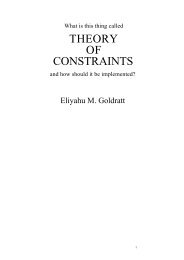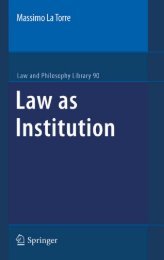Making of a German Constitution : a Slow Revolution
Making of a German Constitution : a Slow Revolution
Making of a German Constitution : a Slow Revolution
Create successful ePaper yourself
Turn your PDF publications into a flip-book with our unique Google optimized e-Paper software.
Conclusion • 253revolution affected slowly, which advances by sensible steps, and takes up ages toreach its termination. It is not, therefore, instantaneous in its nature ... the process <strong>of</strong>a revolution in a legislative system is slow, and consequently there is opportunity forits reformation.’ 8 Filangieri’s theory <strong>of</strong> legislative revolution and Jellinek’s constitutionaltransformation represent two sides <strong>of</strong> the same coin, and, by linking the twotogether through Savigny’s theory <strong>of</strong> politics and modern legislation, we are able todetect the <strong>German</strong> idea <strong>of</strong> revolution and follow its path.In intellectual historical perspective, the fathers <strong>of</strong> the idea <strong>of</strong> making nonviolentBürgerliche <strong>Revolution</strong> in <strong>German</strong>y drew on and rationalized specifically age-old,<strong>German</strong> political traditions and modes <strong>of</strong> resistance. Accordingly, in the first instance,delineating the <strong>German</strong> idea <strong>of</strong> revolution has involved making the uniquely<strong>German</strong> conception <strong>of</strong> sovereignty and its identification with local iurisdictio visible.The conception <strong>of</strong> sovereignty, as it developed in <strong>German</strong>-speaking Europe, centredon the power to make and effect law, a rechtliche Weltanschauung and consciousnessthat had its roots not in ideas, but in the practices <strong>of</strong> the many <strong>German</strong> city-statesand autonomous regions. The practice <strong>of</strong> local jurisdiction was not organized ona theoretical basis until it was challenged by the competing suzerain ambitions <strong>of</strong>popes and princes alike during the period <strong>of</strong> urbanization and Verdorfung betweenthe twelfth and thirteenth century. Local communities faced the need to fend-<strong>of</strong>fthe legal effects <strong>of</strong> both classical canon law, which was used to effect the Papal<strong>Revolution</strong>, and the Reception <strong>of</strong> Roman law, which princes claimed as a basis <strong>of</strong>secular authority. In the midst <strong>of</strong> this, the development <strong>of</strong> urban law and inter-cityRechtskreise, particularly amongst the Hansa cities, emerged from local practice andin opposition to would-be authority imposed from outside. It was the Bologneseglossator Azo who <strong>of</strong>fered the first rationalization <strong>of</strong> local iurisdictio. His viewsshaped the conception <strong>of</strong> sovereignty that was handed down through Bartolus to keypolitical thinkers in the <strong>German</strong> world, including Conrad Celtis. Indeed, even beforethe Reformation, the use <strong>of</strong> the technical element <strong>of</strong> Roman law to gradually effect arationalization, systematization, pr<strong>of</strong>essionalization and scientization <strong>of</strong> <strong>German</strong> lawwas well underway. The aim <strong>of</strong> municipal reformatio was to nullify the influence <strong>of</strong>classical canon law, and this was not only a harbinger <strong>of</strong> the Reformation to come,but shows that legal conflict was at the heart <strong>of</strong> the Reformation.Continuing identification <strong>of</strong> jurisdiction as the basis <strong>of</strong> sovereignty was againa significant factor in the development <strong>of</strong> Herman Conring’s civic consciousnessand principles <strong>of</strong> right to self-governance. His Discursus novus (1642) exploded themyth <strong>of</strong> Roman imperium in <strong>German</strong>-speaking Europe and with it the legitimacy<strong>of</strong> Roman law. Here again, it was a matter <strong>of</strong> time before, by the second half <strong>of</strong> theeighteenth century, the proto-rationalization <strong>of</strong> the <strong>German</strong> law served as a basisfor resistance to would-be absolutism in Württemberg and elsewhere. The strength<strong>of</strong> self-governing practice was evident in Johann Jakob Moser’s publication <strong>of</strong> hisCommunal Ordinance (1758), which was a handbook on self-governance, accordingto the local constitutional arrangements and laws. This traditional and continuing




